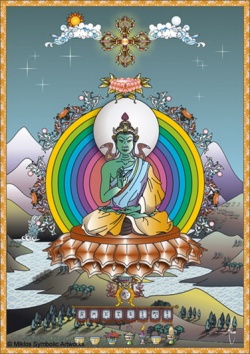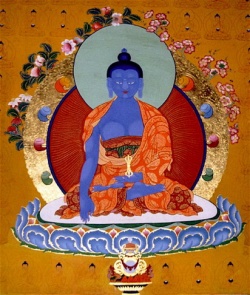Difference between revisions of "Five buddha families"
Jump to navigation
Jump to search
(Redirected page to Five Buddha Families) |
|||
| (6 intermediate revisions by 3 users not shown) | |||
| Line 1: | Line 1: | ||
| − | # | + | '''[[Five buddha families]]''' (Skt. ''[[pañcakula]]''; [[Wyl.]] ''[[rigs lnga]]'', Tib. ''[[rik nga]]'') — [[five buddha families]] ([[rig nga]]): The [[buddha]], [[vajra]], [[ratna]], [[padma]], and [[karma]] families. |
| + | |||
| + | [[File:A_amogasiddhi.jpg|thumb|250px|]][[File:Akshobhya24.jpg|thumb|250px|]] | ||
| + | #[[buddha family]] (Skt. ''[[tathāgatakula]]''; [[Wyl.]] ''[[de bzhin gshegs pa'i rigs]]'') | ||
| + | #[[vajra family]] (Skt. ''[[vajrakula]]''; [[Wyl.]] ''[[rdo rje'i rigs]]'') | ||
| + | #[[ratna family]] or [[jewel family]] (Skt. ''[[ratnakula]]'') | ||
| + | #[[padma family]] or [[lotus family]] (Skt. ''[[padmakula]]''; [[Wyl.]] ''[[pad ma'i rigs]]'') | ||
| + | #[[karma family]] or [[action]] family (Skt. ''[[karmakula]]'') | ||
| + | |||
| + | |||
| + | {|align="center" border="1" cellpadding="15" cellspacing="1": | ||
| + | |colspan="6" align="center"|'''Diagram of the [[Five Buddha Families]]'''<ref>Version based on the [[Nyingma]], [[inner tantras]]</ref> | ||
| + | |- | ||
| + | |align="center"|'''family'''||'''[[buddha]]'''||'''[[vajra]]'''||'''[[ratna]]'''||'''[[padma]]'''||'''[[karma]]''' | ||
| + | |- | ||
| + | |'''direction'''||centre||east||south||west||north | ||
| + | |- | ||
| + | |'''colour'''||blue||white||yellow||red||green | ||
| + | |- | ||
| + | |'''family symbol'''||eight-spoked wheel||vajra||jewel||lotus||[[double vajra]] or sword | ||
| + | |- | ||
| + | |'''{{Wiki|masculine}} [[buddha]]'''<ref>each family is associated with one of the [[buddhas of the five families]]</ref>||[[Vairochana]]<ref>in the [[Sarma]] [[tantras]], [[Akshobhya]] is often at the centre of the [[mandala]], instead of [[Vairochana]]</ref>||[[Vajrasattva]]-[[Akshobhya]]<ref>in the [[Sarma]] [[tantras]], [[Vairochana]] is often in the eastern [[direction]], instead of [[Akshobhya]]</ref>||[[Ratnasambhava]]||[[Amitabha]]||[[Amoghasiddhi]] | ||
| + | |- | ||
| + | |'''[[wisdom]]'''<ref>each [[buddha]] is associated to one of the [[five wisdoms]]</ref>||[[wisdom of dharmadhatu]]||[[mirror-like wisdom]]||[[wisdom of equality]]||[[wisdom of discernment]]||[[all-accomplishing wisdom]] | ||
| + | |- | ||
| + | |'''[[poison]]'''<ref>each [[wisdom]] is a transmutation of one of the [[five poisons]]</ref>||[[delusion]] or [[ignorance]]||[[anger]]||[[pride]]||[[desire]]||[[jealousy]] | ||
| + | |- | ||
| + | |'''[[skhanda]]'''<ref>each [[buddha]] is associated to one of the [[five skandhas]]</ref>||form||consciousness||feeling||perception||formations | ||
| + | |- | ||
| + | |'''{{Wiki|feminine}} [[buddha]]'''<ref>in union with each of the [[five buddhas]]</ref>||[[Dhatvishvari]]||[[Buddhalochana]] or [[Mamaki]]||[[Mamaki]] or [[Lochana]]||[[Pandaravasini]]||[[Samayatara]] | ||
| + | |- | ||
| + | |'''[[element]]'''<ref>each {{Wiki|female}} [[buddha]] represents the [[purity]] of one of the [[five elements]]</ref>||space||water||earth||fire||air | ||
| + | |- | ||
| + | |} | ||
| + | |||
| + | {{reflist}} | ||
| + | |||
| + | ==Further Reading== | ||
| + | *[[Chögyam Trungpa]], | ||
| + | **''Journey Without Goal: The [[Tantric]] [[Wisdom]] of the [[Buddha]]'', The Collected Works of [[Chögyam Trungpa]], Volume Four (Boston & {{Wiki|London}}: [[Shambhala]], 2003), Ch. 9 'The [[Five Buddha Families]]'. | ||
| + | **''The [[Lion’s Roar]]: An Introduction to [[Tantra]]'', The Collected Works of [[Chögyam Trungpa]], Volume Four (Boston & {{Wiki|London}}: [[Shambhala]], 2003), Part Two, Ch. 7 'The [[Five Buddha Families]] and [[Mahamudra]]'. | ||
| + | |||
| + | ==See Also== | ||
| + | *[[buddhas of the five families]] | ||
| + | *[[five female buddhas]] | ||
| + | *[[five wrathful herukas and their five consorts]] | ||
| + | |||
| + | ==External Links== | ||
| + | *[http://www.shambhala.org/teachings/view.php?id=114 The Five Buddha Families by Chögyam Trungpa] | ||
| + | |||
| + | {{RigpaWiki}} | ||
| + | |||
| + | [[Category:Five Buddha Families]]{{BuddhismbyNumber}} | ||
Latest revision as of 10:26, 22 April 2014
Five buddha families (Skt. pañcakula; Wyl. rigs lnga, Tib. rik nga) — five buddha families (rig nga): The buddha, vajra, ratna, padma, and karma families.
- buddha family (Skt. tathāgatakula; Wyl. de bzhin gshegs pa'i rigs)
- vajra family (Skt. vajrakula; Wyl. rdo rje'i rigs)
- ratna family or jewel family (Skt. ratnakula)
- padma family or lotus family (Skt. padmakula; Wyl. pad ma'i rigs)
- karma family or action family (Skt. karmakula)
| Diagram of the Five Buddha Families[1] | |||||
| family | buddha | vajra | ratna | padma | karma |
| direction | centre | east | south | west | north |
| colour | blue | white | yellow | red | green |
| family symbol | eight-spoked wheel | vajra | jewel | lotus | double vajra or sword |
| masculine buddha[2] | Vairochana[3] | Vajrasattva-Akshobhya[4] | Ratnasambhava | Amitabha | Amoghasiddhi |
| wisdom[5] | wisdom of dharmadhatu | mirror-like wisdom | wisdom of equality | wisdom of discernment | all-accomplishing wisdom |
| poison[6] | delusion or ignorance | anger | pride | desire | jealousy |
| skhanda[7] | form | consciousness | feeling | perception | formations |
| feminine buddha[8] | Dhatvishvari | Buddhalochana or Mamaki | Mamaki or Lochana | Pandaravasini | Samayatara |
| element[9] | space | water | earth | fire | air |
Footnotes
- ↑ Version based on the Nyingma, inner tantras
- ↑ each family is associated with one of the buddhas of the five families
- ↑ in the Sarma tantras, Akshobhya is often at the centre of the mandala, instead of Vairochana
- ↑ in the Sarma tantras, Vairochana is often in the eastern direction, instead of Akshobhya
- ↑ each buddha is associated to one of the five wisdoms
- ↑ each wisdom is a transmutation of one of the five poisons
- ↑ each buddha is associated to one of the five skandhas
- ↑ in union with each of the five buddhas
- ↑ each female buddha represents the purity of one of the five elements
Further Reading
- Chögyam Trungpa,
- Journey Without Goal: The Tantric Wisdom of the Buddha, The Collected Works of Chögyam Trungpa, Volume Four (Boston & London: Shambhala, 2003), Ch. 9 'The Five Buddha Families'.
- The Lion’s Roar: An Introduction to Tantra, The Collected Works of Chögyam Trungpa, Volume Four (Boston & London: Shambhala, 2003), Part Two, Ch. 7 'The Five Buddha Families and Mahamudra'.

